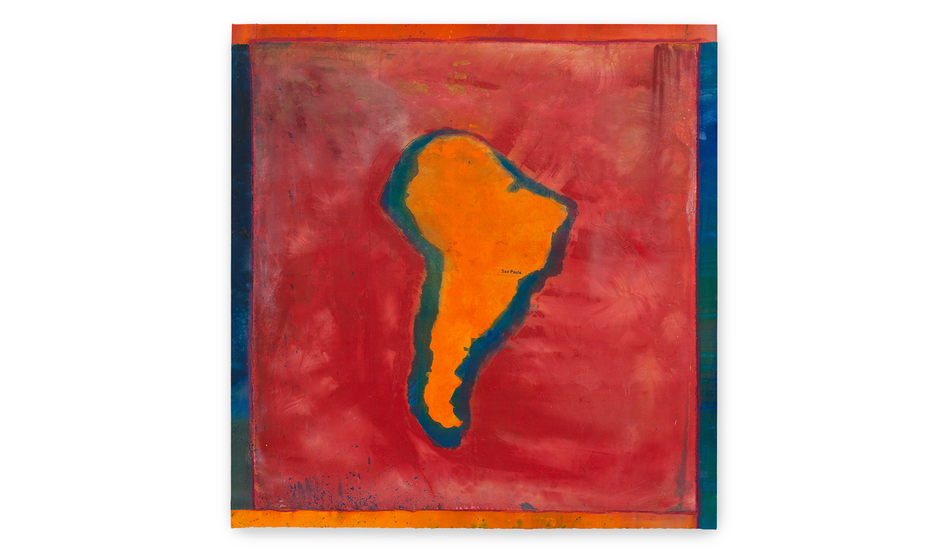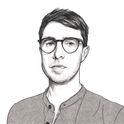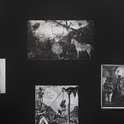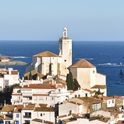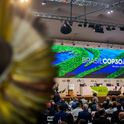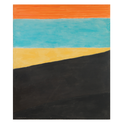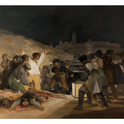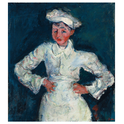Looking at an artwork sat on the floor of an artist’s studio, it takes on an altogether different aspect to one on the gallery wall. Even when finished, there’s something inherently contingent about it; so long as it stays in the studio, where it first emerged from nothing, the final word is yet to be had. “I sometimes feel that the painting is not really complete until it hangs in an exhibition space,” the artist Frank Bowling tells me. “I think that something sort of romantic goes on with the curation, a magic fruition and stirring. The curators do something that creates a kind of conversation between the art and the audience.”
It’s down a cobblestoned yard in south London, in one of a series of little buildings originally built to house craftspeople in the 1880s (and home to Bowling’s own studio for many years), that I find September sitting in this state of incompleteness—or, rather, predestination. Bowling is busy preparing September and other works to be shipped over to Brazil for this year’s São Paulo Biennial, which will be his first time showing in the country and only his second in South America, where he was born in 1934. “Growing up in British Guiana on the edge of South America, next to Venezuela and Surinam bordering Brazil, I always thought of this as being one terrain, a kind of landmass made up of coastline, bush, savannah, that kind of thing,” Bowling tells me. “I made a couple of paintings referring to Mount Roraima, this ancient mysterious mountain that is in Guyana; but the thing is that Roraima is also in Brazil and in Venezuela.”
In September we find the continent surrounded by a dazzling red field, glowing orange, gilded by blue and, fittingly, without borders. “I think this painting really comes off because of the colours,” Bowling says. “There was a dark outline around the map shape from the screenprint, but the blue that I painted on makes a marvelous outline in a surprising way. All the maps I’ve worked with have an outline, but in this one it stands out deliberately; it’s neater. I remember trying to flatten out the paint as the printing process indicated, to make it three dimensional in paint rather than in fact.
“I didn’t know I had it in me to make such a blue,” Bowling adds, “a blue that resembles the kind of mechanical device used for printing, but that’s the spontaneity of it all. With that outline, the map comes off as a sort of painted image, like it’s jumping! There’s something very three dimensional about this work, even though it is flat as a pancake; the feeling one gets from it is of something real in that space.”
Bowling is famous for his paintings of maps, which he’s made variously via stencils, epidiascope and silkscreen printing; this particular image comes from a silkscreen that dates all the way back to 1968. “The South America screen had been conserved and brought back to the studio at around the same time that I was thinking about new work for Brazil,” Bowling says, “and there was a conversation in the studio about the lettering on the map. The rivers were marked clearly—Amazon and Negro—and there’s Venezuela and ‘Horizo’, which could be Belo Horizonte. But the only city written out in full was São Paulo. When one of my sons asked me why that was, I said what I felt, which was that I always wanted to go there!” It’s these letters alone, demarcating Brazil’s biggest city, that Bowling has left on the final image—preventing it from teetering over the edge into total abstraction, as something still “representative of reality,” as Bowling puts it.
Given where September will be shown—not to mention the month of the year the biennial takes place—it would be tempting to suggest that the title of the work was there from the start. But for Bowling the title behind every work is a process in and of itself. “I almost always name a painting only once it is finished,” Bowling says. “In this case, the September thing has a few associations, one being my affection for my stepdaughter Marcia Scott, who is also an artist, and her birthday is in September—I have this belief in the magic of birth dates and September has a kind of steady reality. I was aware that the São Paulo Biennial was opening in September and it’s also the hottest month in Guyana, where you have these days of burning heat. It’s an extremely intense humid heat and I suppose that the fiery reds and oranges in September are reminiscent of the kind of heat that I remember from my childhood.”
September is one of the most recent paintings Bowling will have on show in São Paulo, and it will also be the first to greet visitors at his retrospective. Bowling is now 91, and, while he still paints every day, he’s disappointed that he won’t be there for the opening. “Although I will not now ever make it to São Paulo in my body,” he says, “I will be there in my paintings. And you know, I’m visiting South America all the time in my dreams and daydreams. I’m brought back to memories of the fishes in South America and the water creatures—the frogs, the crabs and the scales on the fishes, the shells.”
